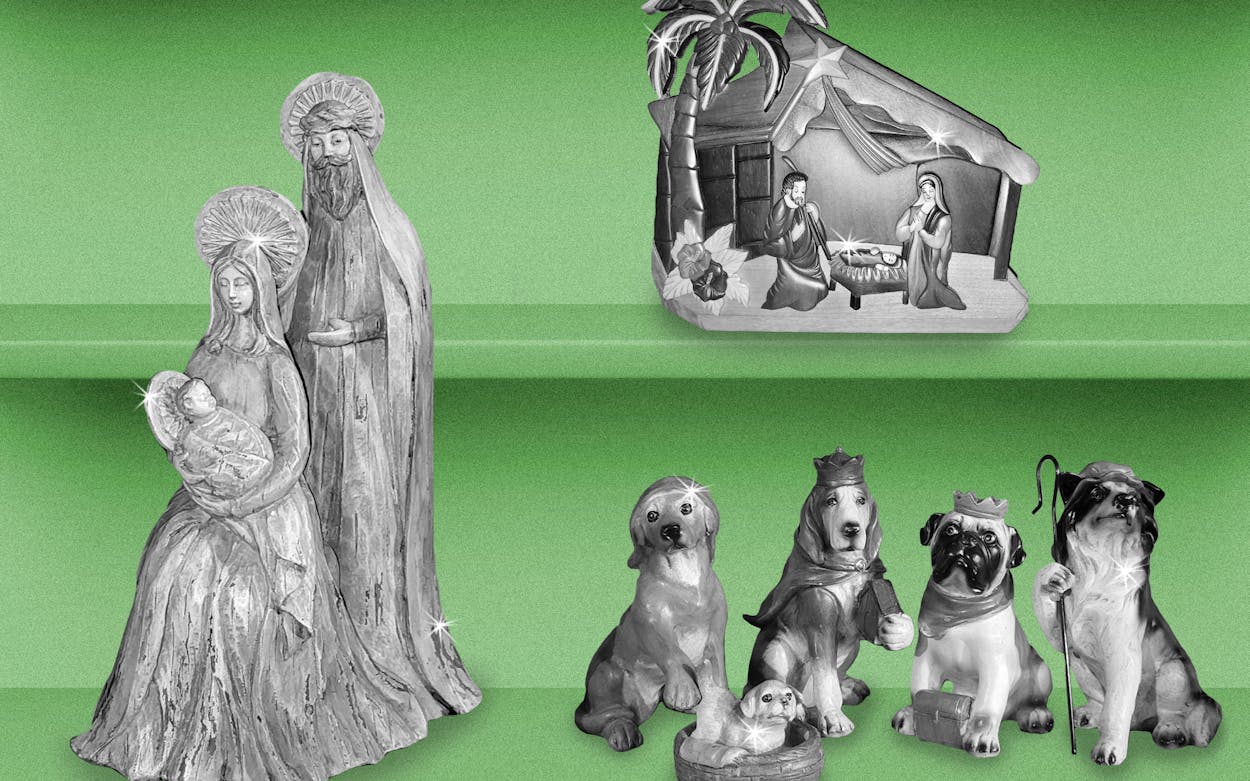The collection
Six hundred Nativity sets.
The tiniest artifact
A Nativity rendered out of pinto beans and glued onto an overturned salsa dish.
The best method of procurement
One set came by way of a New York dumpster, where it was trashed when a Hallmark store went out of business.
Of all the holiday decor present this time of year—the Santa hats, the sprigs of garland—the Nativity set remains the sole figurative representation of the reason for the Christmas season.
Growing up visiting her grandparents in Flatonia, a town about an hour southeast of Austin, Veronica Koliba remembers how her grandmother would forgo the snowmen and elves in favor of a lone Nativity set, with its classic ceramic figurines of Mary, Joseph, baby Jesus, the three wise men, and all the animals in the stable. The display was prayed over and revered, the epitome of Christmas decor for Koliba and her family. But her grandmother had just the one set, and Koliba now has nearly six hundred.
When Koliba first had the idea for her exhibition, her intent was never to amass over four gross of them. The plan, inspired by a similar but smaller project, was to curate her Port Lavaca community’s Nativity sets and compile them into a display, on view throughout the holiday season. “It’s just beautiful in there,” she says of the finished exhibit. “It’s art and culture and religion all together.”
In 2020, she put out a call in the local newspaper asking folks to donate their figurines for temporary use in the showcase. She got two responses, and thus a mad dash to source sets began. That first year, the Nativity exhibit at the Red Barn ended up with a respectable one hundred sets on display.
Three years later, Koliba’s collection has grown by five hundred, aided by a few donors, but largely thanks to her and her husband Kevin’s weekend trips to far-flung Texas towns. Their purchases, from antique shops and estate sales as remote as Beeville, Odem, Refugio, and Sinton, fill the 5,200-square-foot space they once utilized as a venue for weddings and private events, and now hold onto as a Nativity museum-slash-storage facility. The diversity of the different sets is the draw, both for Koliba and for the folks that visit the Nativity exhibit at the Red Barn each year. Some sets are big, taking up the center of a table; some can fit in the palm of your hand. She’s collected Nativities made of banana leaves, dishwasher soap bottles, pinto beans, plastic, metal, wood, glass, and stone. They come from a variety of cultures, from Mexico to South Africa, and from the resale shops of many, many Texas towns. There’s a wizard-themed set, one featuring cats and dogs as Mary and Joseph, and another created out of marshmallows, graham crackers, and other s’mores supplies. A few are missing the baby Jesus or a random hand. “Nobody wants those,” Koliba says. Nobody, except for her.
Koliba begins the careful unpacking and assembling of the sets in late October. Each individual Nativity is itself a small collection of figurines, but Koliba says the long setup process is “like playing with toys” and “rewarding and therapeutic.”
Like any good curator, she provides labels detailing each set’s provenance (Abilene, Fredericksburg, San Antonio, Temple), so that the tour of different materials, art styles, and cultures also becomes a tiny tour of Texas towns.
The stories of procurement are just as unique. She once “bought a box of rocks,” her uncle likes to remind her, at the gift shop of a home for disabled adults; the rocks are made up to look like the Christmas characters. Another set came courtesy of a pregnant donor who dumpster-dove for the figurines after a Hallmark in New York went out of business. Contributing pieces to one Texas-themed set has become a new family tradition, with a bluebonnet or Longhorn added each year. And of course her grandmother’s traditional, vintage set, the one from Koliba’s childhood, is on display each year.
Guests who visit Koliba’s exhibit from other areas of the state always want to know if she’ll continue her collection, if there’s ever an end point to her curation. Her boss once asked her, do you want to have the most Nativities this side of the Mississippi?
But Koliba has never really been interested in a set number of sets (though six hundred is probably up there). “I was going after quality or different,” she says. “I want the ones that nobody wants. I want the ones I don’t have.”
- More About:
- Style & Design
- Port Lavaca








